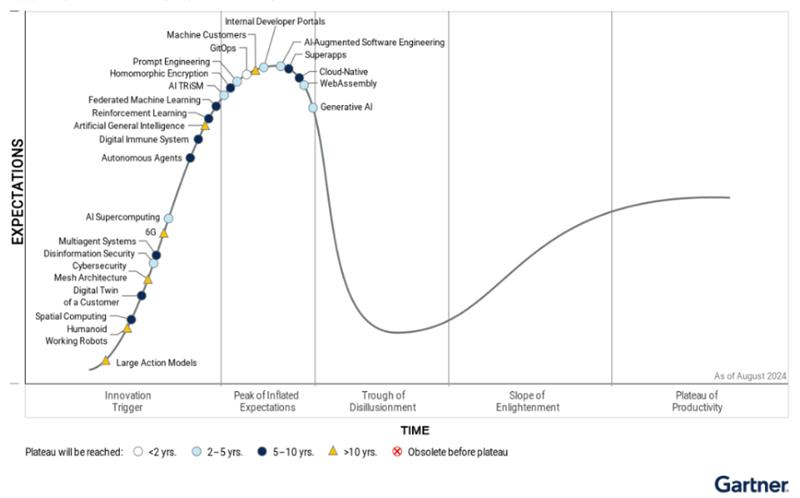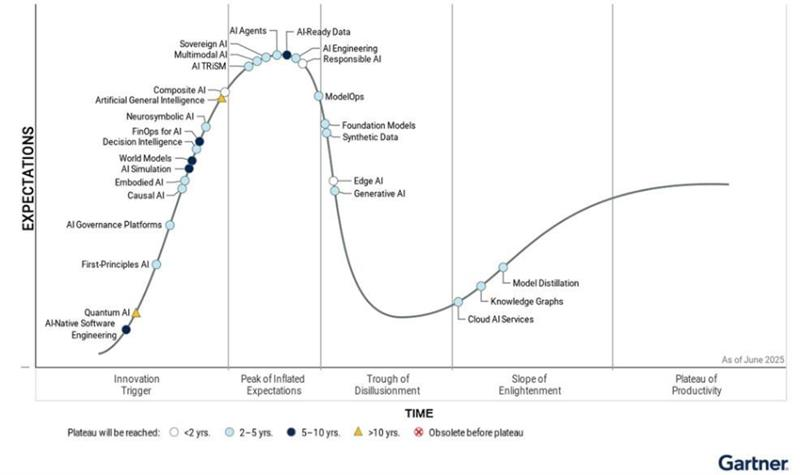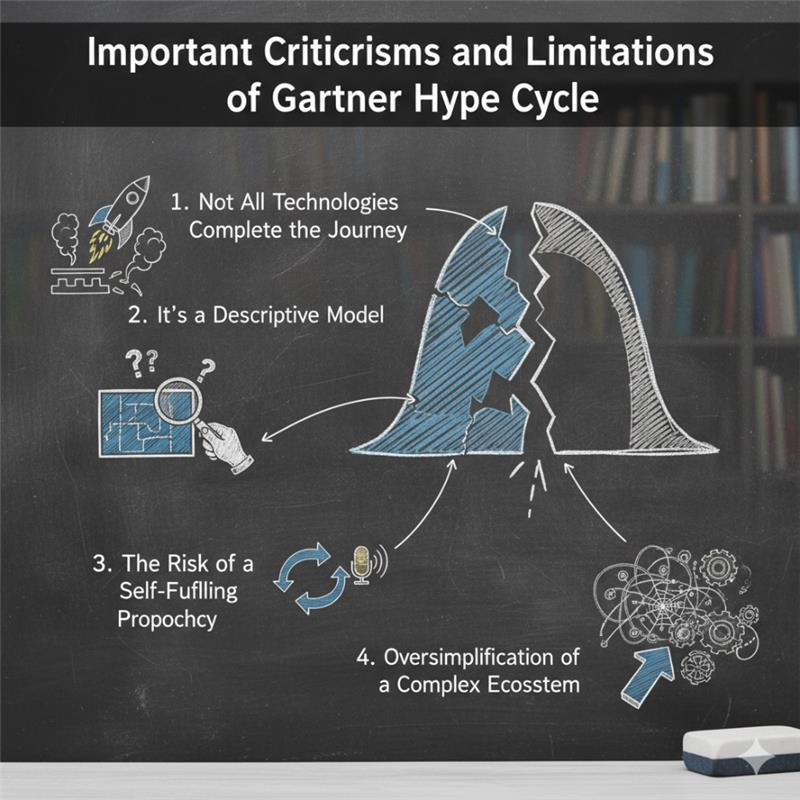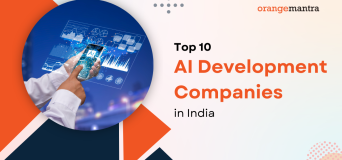
Discover how the Gartner Hype Cycle helps you separate genuine innovation from overhyped trends. Learn its five phases—from the Innovation Trigger to the Plateau of Productivity—and how businesses, entrepreneurs, and investors can use it to make smarter technology decisions.
What You’ll Learn:
- The five key phases of the Gartner Hype Cycle and what each represents
- How to identify where a technology stands in its maturity journey
- Practical ways to use the Hype Cycle for business strategy and investment decisions
- Insights on applying the model for AI and emerging technologies
- Common limitations and criticisms of the Gartner Hype Cycle
- Real-world examples from the 2025 AI Hype Cycle and leadership perspectives
You hear about it in keynote speeches, see it splashed across tech news sites, and watch it go viral on social media. It’s the next big thing. It’s a revolutionary technology that promises to reshape industries, redefine human interaction, and solve problems we didn’t even know we had.
Yesterday, it was the Metaverse. Today, it’s Agentic AI. Tomorrow, it will be something else.
This relentless wave of innovation is exhilarating. But it’s also exhausting.
How can you, as a business leader, an entrepreneur, or simply a curious observer, separate the genuinely transformative signals from the deafening noise of short-lived fads?
How do you know when to invest your attention, resources, or capital, and when to step back and let the dust settle?
Thankfully, you don’t have to navigate this chaotic landscape alone. For decades, a powerful model has served as a trusted map for this treacherous territory: the Gartner Hype Cycle.
This framework acknowledges the hype, explains it, charts its predictable path, and reveals the journey every emerging technology takes towards mainstream usefulness.
In this article, we’ll learn what the Gartner Hype Cycle is. We’ll walk through its five critical phases and explore how to use it to make smarter decisions. By the end, you’ll have a powerful new lens through which to view the next “world-changing” breakthrough.
Table of Contents
What Exactly is the Gartner Hype Cycle?
Before we dive into its twists and turns, let’s establish what the Gartner Hype Cycle actually is. In essence, it’s a graphical representation, a curve that illustrates the life cycle of a technology from its initial invention to its ultimate maturity and widespread adoption.
You can imagine this as a staged model of public and market perception. It was created by Gartner, one of the world’s leading research and advisory companies, to help their clients understand the maturity of emerging technologies and separate the hype from the reality.
The core premise is both simple and powerful: technologies tend to follow a predictable pattern of intense enthusiasm, painful disillusionment, and a gradual, steady climb toward genuine productivity. It’s a story of human psychology as much as it is of technological progress.
We get collectively over-excited, then collectively disappointed, before we finally figure out how a tool truly fits into our world.

Image Source: Hype Cycle for Emerging Technologies 2024
The Hype Cycle’s primary value lies in its ability to:
- Manage Expectations: It normalizes the “trough of disillusionment,” showing that a technology becoming unfashionable doesn’t mean it’s dead. It can also mean it’s entering a critical stage of development.
- Inform Strategy: It provides a framework for deciding when to engage with a technology. Should you be a pioneering innovator, a pragmatic fast-follower, or a cost-conscious late adopter?
- Track Evolution: Gartner’s annual “Hype Cycle for Emerging Technologies” report serves as a crucial industry barometer. This allows businesses to benchmark their own technology radar against expert analysis.

Image Source: Hype Cycle for Artificial Intelligence 2025
A Deep Dive into The Five Phases of the Hype Cycle
The true genius of the Gartner Hype Cycle lies in its breakdown of a technology’s journey into five distinct and predictable phases. If you understand each stage, you will get the key to diagnosing where a technology stands today and anticipating where it’s headed tomorrow. Let’s walk the curve from start to finish.
Phase 1. The Innovation Trigger
This is the spark that ignites the journey. The Innovation Trigger is a breakthrough. It is a successful proof-of-concept, a product launch, or a landmark event that pushes a technology into the public consciousness.
What happens in this phase is that the technology is in its earliest or most raw form. There might be lab experiments, press releases from research institutions, or prototype demonstrations. Media outlets pick up the story, generating the first wave of buzz among tech enthusiasts and visionaries.
At this point, there are no commercially viable products, and the practical application is largely speculative. The buzz is all about potential.
To make you understand this, we can take an example of the first successful demonstrations of quantum computers solving problems impractical for classical machines.
Phase 2. The Peak of Inflated Expectations
This is the phase we most commonly associate with “hype.” It is a wave of success stories which are often fueled by early adopters and marketing; creating a frenzy of excitement.
So, in this phase, unrealistic expectations soar. The technology is touted as a silver bullet that will disrupt entire industries overnight. Startups flock to the space, venture capital flows freely, and a “fear of missing out” (FOMO) drives both investment and media coverage.
During this peak, the technology inevitably fails to meet these inflated expectations in the short term. Some early implementations deliver, but many high-profile failures occur. A very recent example is the initial NFT (Non-Fungible Token) craze, where every piece of digital art was proclaimed as a revolutionary asset class, leading to speculative bubbles.
Phase 3. The Trough of Disillusionment
Gravity always wins. As the technology fails to deliver on its overblown promises, interest wanes, and negative press kicks in.
The technology becomes unfashionable. The same media that championed it now writes its obituary. Widespread disillusionment sets in. Many of the weaker vendors and products that emerged during the peak run out of funding and are consolidated or fail entirely.
You remember the period after the initial excitement around consumer VR? The market realized the hardware was expensive and content was limited which led to a perceived slowdown. This is the closest example we can give you about phase 3.
This trough is not a sign of the technology’s ultimate failure, but a necessary weeding-out process. It is a period of purification where the focus shifts from hype to the hard work of solving real problems.
Phase 4. The Slope of Enlightenment
The climb out of the trough is slow, steady, and far less glamorous. But this is where the real magic happens. The surviving providers refine their products, and businesses begin to understand the technology’s practical application and benefits.
The focus shifts from what the technology is to what it can do. Second and third-generation products appear. Methodologies and best practices become established. More businesses run successful pilots and start to see a return on investment.
The technology isn’t mainstream yet, but its value is becoming clear to a growing, pragmatic audience. The conversation becomes more nuanced and solution-oriented.
You can easily relate this with the example of AI. Businesses are now integrating AI for specific, high-value tasks like automating customer service chats, detecting financial fraud, or optimizing supply chains.
Phase 5. The Plateau of Productivity
The technology finally reaches maturity and mainstream adoption. Its real-world benefits are demonstrable and widely accepted.
In this phase, the technology becomes stable and understood. Its market applicability is clear, and it evolves into a reliable tool. The final height of the plateau varies; some technologies become ubiquitous (like the cloud), while others find a stable, niche market.
Here, the technology is no longer emerging. It’s simply a part of the toolkit. Its adoption is driven by proven ROI and competitive necessity, not by hype.
For example, Cloud Computing has firmly reached this stage. It’s no longer a disruptive trend but a standard, foundational element of modern business infrastructure.
Now that we understand the journey, let’s explore how you can apply this knowledge to make smarter, more strategic decisions.
Why Should You Care About Gartner Hyper Cycle? Practical Applications
You might be thinking, “This is a fascinating theory, but how does it impact me?” The true power of the Hype Cycle isn’t just in understanding technology’s journey. The true power is in using that knowledge to make smarter, more strategic decisions.
Whether you’re a business leader, an entrepreneur, or an investor, this framework provides a crucial advantage.
For Business Leaders & Strategists:
- Timing Your Investments: The Hype Cycle is an essential tool for deciding when to engage.
- Innovators jump in during the “Innovation Trigger” to gain a first-mover advantage.
- Early Majority/Pragmatists should start pilot projects on the “Slope of Enlightenment,” where the technology is more stable, and best practices are emerging. This offers a better risk-reward balance.
- Late Majority/Conservatives can confidently invest on the “Plateau of Productivity,” when the technology is a proven, standardized commodity.
- The key is to avoid making major, core-business investments at the “Peak of Inflated Expectations,” when costs are high and realistic use cases are unclear.
- Managing Stakeholder Expectations: This is one of the most immediate applications. When a promising technology your company invested in hits the “Trough of Disillusionment,” you can use the Hype Cycle to explain to your board, team, or investors that this is a natural and expected phase, not a signal of failure. It reframes the conversation from “We bet on the wrong thing” to “We are navigating a predictable phase on the path to value.”
For Entrepreneurs & Developers:
- Identifying Real Opportunity: The “Trough of Disillusionment” can be the best time to build. The market noise has died down, the real problems and limitations are clear, and the “tourists” have left. This allows you to focus on solving genuine, valuable problems for a specific audience without the distraction of hype.
- Strategic Positioning: Understanding the cycle helps you message your product correctly. If your technology is in the Trough, your marketing should focus on practicality, ROI, and specific solutions, not on revolutionary (and unbelievable) promises.
For Investors & Venture Capitalists:
- The Hype Cycle helps in mapping the investment landscape. It can signal when a sector is becoming over-heated (the Peak) or when it might be a good time to look for undervalued, fundamentally sound companies that are quietly building during the Trough.
For Consumers & Tech Enthusiasts:
- It helps you become a smarter adopter. The Hype Cycle answers the classic question: “Should I buy the Version 1.0 of this new gadget?” If it’s at the Peak, the answer is probably no. Then you should wait for the kinks to be worked out as it progresses to the Slope of Enlightenment.
Important Criticisms and Limitations of Gartner Hyper Cycle
It is true that the Gartner Hype Cycle is an incredibly useful model. But it’s crucial to remember that it is just a model. It simplifies a complex reality to provide clarity, and in doing so, it has some inherent limitations.

-
Not All Technologies Complete the Journey
The most significant criticism is the assumption that every technology will successfully traverse all five phases. This is not the case.
Many technologies die in the “Trough of Disillusionment.” They may fail to find a viable market, be overtaken by a superior alternative, or simply prove too expensive or impractical to ever reach mainstream adoption.
Think of Google Glass (in its initial consumer form) or many early-generation 3D televisions. The Hype Cycle curve, for these technologies, is a cliff, not a slope.
-
It’s a Descriptive Model
The Hype Cycle is excellent for diagnosing the current phase of a technology. But it is notoriously bad at predicting timelines. How long will a technology languish in the Trough? A year? A decade? The model gives no answer.
The journey from Innovation Trigger to the Plateau of Productivity can be lightning-fast for some technologies (like the modern smartphone) and agonizingly slow for others (like artificial intelligence).
-
The Risk of a Self-Fulfilling Prophecy
As a highly influential publication from a leading research firm, the Hype Cycle itself can actively shape the market it seeks to describe. By placing a technology on the “Peak,” Gartner can contribute to the very inflation of expectations.
Conversely, labeling a technology as being in the “Trough” can accelerate disillusionment and starve projects of needed investment. In this way, the model doesn’t just observe the cycle; it can sometimes become an actor within it.
-
Oversimplification of a Complex Ecosystem.
The model often treats a technology as a single, monolithic entity. In reality, different applications of the same core technology can be in different phases simultaneously.
For example, while “Generative AI for enterprise content creation” might be nearing its peak, “Generative AI for drug discovery” could still be on the innovation trigger.
And “AI for predictive maintenance” might already be on the Slope of Enlightenment. The single line of the Hype Cycle can mask this intricate reality.
The Hype Cycle in Action: A 2025 AI Spotlight
Theories are powerful. But they are proven by their application in the real world. The recently published “Gartner Hype Cycle for Artificial Intelligence, 2025” offers a perfect case study. It shows exactly how this model plays out in today’s most dynamic field.
According to Gartner, four key innovations are currently cresting the “Peak of Inflated Expectations”:
- AI Agents: Autonomous systems that can perform complex tasks.
- AI-Ready Data: The crucial, high-quality data that fuels reliable AI.
- Multimodal AI: Models that can process and understand text, images, and audio simultaneously.
- AI TRiSM (Trust, Risk, and Security Management): The frameworks needed for ethical and secure AI deployment.
Gartner’s identification of these technologies at the peak is a critical signal for businesses. It confirms that while the potential is enormous, we are also in a period of intense speculation and ambitious promises.
As the model predicts, a period of disillusionment for some of these applications is inevitable as the market separates the viable from the vaporware.
A Leader’s Perspective: Navigating the AI Peak
By Vinit Chaudhary, CEO orangemantra
When I read Gartner’s latest Hype Cycle, I don’t see a warning to stand back. I see a strategic playbook for pragmatic leaders. It validates the conversations we’ve been having with our clients and within our own walls.
-
AI Agents & Multimodal AI:
As a leader who has guided companies through multiple tech cycles, I know that the siren song of the “fully autonomous” future can lead you onto the rocks.
The winners in this race won’t be the ones chasing the most futuristic demo. They will be the ones who ask, “What specific, high-value problem can we solve today?”
At our Agentic AI development company, we draw a clear line. An AI agent that promises to fully replace a human team on a complex task? That’s still at the peak.
But an AI co-pilot that empowers that same team by instantly retrieving and synthesizing data from five different systems? That is already climbing the “Slope of Enlightenment,” delivering tangible ROI and building the foundation for what comes next.
-
AI-Ready Data & AI TRiSM:
Gartner has hit the nail on the head. This aligns perfectly with a core principle we’ve always operated on: Your AI strategy is nothing without your data strategy.
The companies that invest now in “AI-ready data” and robust AI TRiSM frameworks are not just checking a box. They are building their immune system for the coming “Trough of Disillusionment.”
While others are paralyzed by data chaos, security fears, and unreliable outputs, these prepared AI development companies will have the clean, trusted, and secure data pipelines to deploy AI effectively and responsibly.
They will turn a period of market-wide disappointment into their own definitive competitive advantage. This is the foundation we help our clients build, because history shows that the most durable castles are built on the strongest bedrock.
Conclusion
In a world of constant technological buzz, the Gartner Hype Cycle offers something invaluable: perspective. It reminds us that the journey from breakthrough to utility is rarely a straight line. But rather a rollercoaster of excitement, disappointment, and ultimately, understanding.
This model teaches us that the “Trough of Disillusionment” is not a graveyard for failed ideas, but a phase where genuine value is forged away from the blinding glare of the spotlight. It empowers us to replace FOMO with strategy and anxiety with insight.
So the next time you encounter a “revolutionary” technology, pause and ask yourself the crucial question: “Where is it on the Hype Cycle?”
This simple act of positioning will transform you from a passive consumer of hype into an active, discerning navigator of the technological landscape. You’ll be equipped to see beyond the peak, through the trough, and focus on what truly matters: the lasting value that emerges on the other side.
FAQs
-
What are the five phases of the Gartner Hype Cycle?
The Gartner Hype Cycle has five phases that show how a new technology grows over time. It starts with the Innovation Trigger, when a new idea or breakthrough catches attention. Then comes the Peak of Inflated Expectations, when excitement and big promises often take over. After that, reality hits in the Trough of Disillusionment, when people realize the technology isn’t perfect yet. The next stage, the Slope of Enlightenment, is when real use cases start proving value. Finally, the Plateau of Productivity is when the technology matures, becomes stable, and gets widely adopted.
-
How can businesses use the Gartner Hype Cycle for AI investment decisions?
The Gartner Hype Cycle helps businesses decide when to invest in a new technology like AI. If you want to lead innovation, you can explore opportunities early when a technology is just emerging. If you prefer a more balanced approach, it’s wiser to wait until the “Slope of Enlightenment,” when real-world results and proven use cases start showing up. For those who want the least risk, the best time is the “Plateau of Productivity,” when the technology is tested, stable, and already delivering clear ROI.
-
What is the difference between the Gartner Hype Cycle and the Technology Adoption Curve?
The Gartner Hype Cycle and the Technology Adoption Curve both talk about how new technologies grow, but from different angles. The Hype Cycle focuses on the hype and perception like how excitement builds and fades before real value appears. The Technology Adoption Curve focuses on people and adoption like how different types of users start using the technology over time, from early adopters to laggards. The Hype Cycle tells you how people feel about technology. The Adoption Curve shows how people use it.






